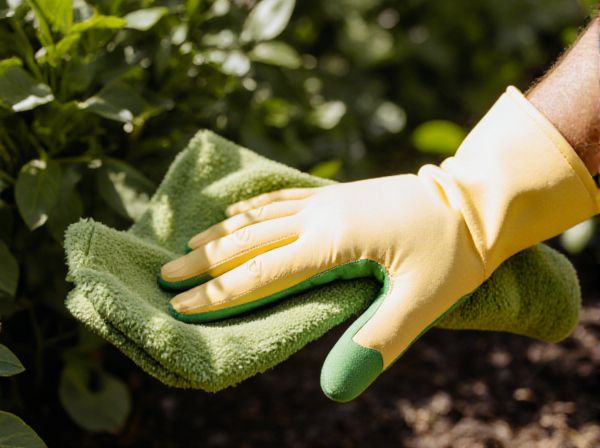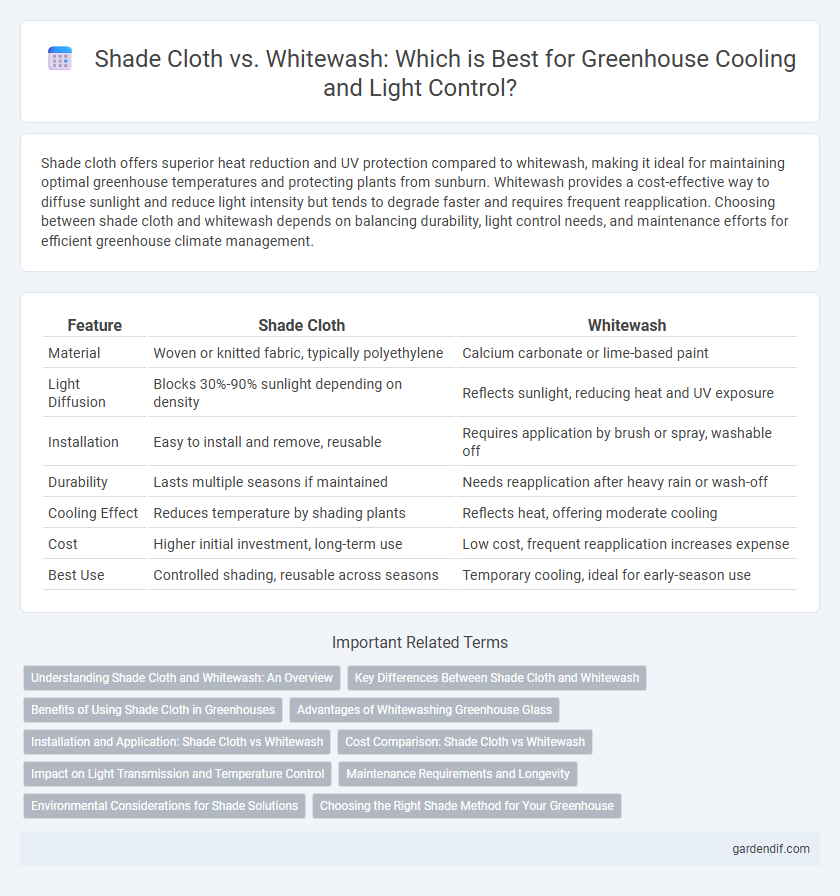
Shade Cloth vs Whitewash Illustration
Shade cloth offers superior heat reduction and UV protection compared to whitewash, making it ideal for maintaining optimal greenhouse temperatures and protecting plants from sunburn. Whitewash provides a cost-effective way to diffuse sunlight and reduce light intensity but tends to degrade faster and requires frequent reapplication. Choosing between shade cloth and whitewash depends on balancing durability, light control needs, and maintenance efforts for efficient greenhouse climate management.
Table of Comparison
| Feature | Shade Cloth | Whitewash |
|---|---|---|
| Material | Woven or knitted fabric, typically polyethylene | Calcium carbonate or lime-based paint |
| Light Diffusion | Blocks 30%-90% sunlight depending on density | Reflects sunlight, reducing heat and UV exposure |
| Installation | Easy to install and remove, reusable | Requires application by brush or spray, washable off |
| Durability | Lasts multiple seasons if maintained | Needs reapplication after heavy rain or wash-off |
| Cooling Effect | Reduces temperature by shading plants | Reflects heat, offering moderate cooling |
| Cost | Higher initial investment, long-term use | Low cost, frequent reapplication increases expense |
| Best Use | Controlled shading, reusable across seasons | Temporary cooling, ideal for early-season use |
Understanding Shade Cloth and Whitewash: An Overview
Shade cloth and whitewash serve distinct purposes in greenhouse management, with shade cloth made from woven or knitted fabric designed to reduce sunlight intensity and control temperature. Whitewash, a reflective paint applied to greenhouse glazing, disperses sunlight to prevent overheating and protects plants from UV damage. Both methods improve plant growth conditions by moderating light and temperature but differ in application, durability, and effectiveness based on plant type and environmental needs.
Key Differences Between Shade Cloth and Whitewash
Shade cloth and whitewash are both effective methods for regulating greenhouse temperature but differ in application and impact. Shade cloth consists of woven material that blocks a specific percentage of sunlight, providing precise control over light intensity and reducing heat buildup without altering the greenhouse structure. Whitewash is a paint-like substance applied directly to surfaces, diffusing sunlight and reflecting heat but requiring periodic reapplication and potentially reducing light transmission more uniformly.
Benefits of Using Shade Cloth in Greenhouses
Shade cloth in greenhouses effectively regulates temperature by blocking up to 90% of solar radiation, reducing heat stress and promoting optimal plant growth. It also allows adequate airflow and light diffusion, preventing overheating while maintaining photosynthesis efficiency. Compared to whitewash, shade cloth provides durable, reusable protection without obscuring light quality or requiring frequent reapplication.
Advantages of Whitewashing Greenhouse Glass
Whitewashing greenhouse glass reduces solar heat gain, helping to maintain lower temperatures during hot weather, which improves plant growth and prevents heat stress. It diffuses light evenly, enhancing photosynthesis by minimizing harsh shadows and promoting uniform light distribution throughout the greenhouse. Whitewash is cost-effective, easy to apply, and provides better UV protection compared to shade cloth, extending the lifespan of both plants and greenhouse materials.
Installation and Application: Shade Cloth vs Whitewash
Shade cloth installation involves securing fabric over the greenhouse frame using clips or ropes, allowing for adjustable shading and ventilation control. Whitewash application requires evenly brushing or spraying a clay and lime mixture onto glass or plastic surfaces to diffuse sunlight and reduce heat. Shade cloth offers flexibility in shading levels and easy removal, while whitewash creates a permanent, low-maintenance light diffusion layer.
Cost Comparison: Shade Cloth vs Whitewash
Shade cloth typically costs between $0.50 and $2.00 per square foot, offering a reusable and durable solution for greenhouse shading, while whitewash presents a lower initial cost averaging around $0.10 to $0.30 per square foot but requires frequent reapplication every few months. The labor and maintenance expenses for whitewash can increase its overall cost over time, making shade cloth more cost-effective for long-term use. Evaluating material lifespan alongside upfront expenses is crucial for optimizing greenhouse budget allocation.
Impact on Light Transmission and Temperature Control
Shade cloth effectively reduces light transmission by blocking up to 70% of sunlight, which helps maintain lower temperatures inside the greenhouse, ideal for heat-sensitive plants. Whitewash reflects a portion of sunlight while diffusing the light, allowing moderate light penetration and providing a cooling effect through increased albedo. Both methods manage temperature control and light intensity, but shade cloth offers more precise shading, whereas whitewash enhances light diffusion for uniform plant growth.
Maintenance Requirements and Longevity
Shade cloth requires minimal maintenance, typically involving periodic cleaning to remove dust and debris, which helps maintain its effectiveness and prolongs its lifespan up to 10 years. Whitewash, composed of diluted lime or other mineral-based mixtures, demands more frequent reapplication, often every 4 to 6 weeks, due to weathering and washing off from rain. The longevity of shade cloth surpasses whitewash, making it a more durable option for consistent shade and protection in greenhouses.
Environmental Considerations for Shade Solutions
Shade cloth offers superior environmental benefits by reducing energy consumption through enhanced temperature control and minimizing water evaporation compared to whitewash. Made from durable, recyclable materials, shade cloth supports sustainability by reducing the need for frequent applications and chemical runoff commonly associated with whitewash treatments. Selecting shade cloth aligns with eco-friendly greenhouse management practices by promoting better plant health and conserving natural resources.
Choosing the Right Shade Method for Your Greenhouse
Choosing the right shade method for your greenhouse depends on factors like climate, plant sensitivity, and cost-effectiveness. Shade cloth offers targeted light filtration and adjustable shading levels, ideal for tropical plants requiring precise control. Whitewash provides a cost-efficient, temporary solution that diffuses sunlight evenly but may require frequent reapplication to maintain optimal shading.
Shade Cloth vs Whitewash Infographic

 gardendif.com
gardendif.com